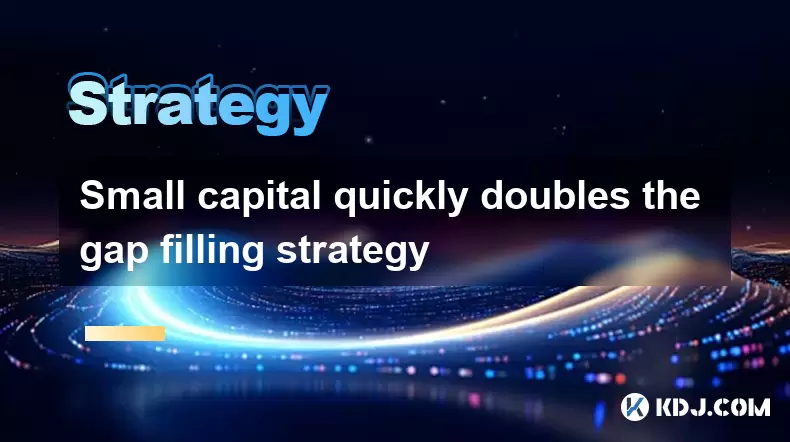-
 bitcoin
bitcoin $87959.907984 USD
1.34% -
 ethereum
ethereum $2920.497338 USD
3.04% -
 tether
tether $0.999775 USD
0.00% -
 xrp
xrp $2.237324 USD
8.12% -
 bnb
bnb $860.243768 USD
0.90% -
 solana
solana $138.089498 USD
5.43% -
 usd-coin
usd-coin $0.999807 USD
0.01% -
 tron
tron $0.272801 USD
-1.53% -
 dogecoin
dogecoin $0.150904 USD
2.96% -
 cardano
cardano $0.421635 USD
1.97% -
 hyperliquid
hyperliquid $32.152445 USD
2.23% -
 bitcoin-cash
bitcoin-cash $533.301069 USD
-1.94% -
 chainlink
chainlink $12.953417 USD
2.68% -
 unus-sed-leo
unus-sed-leo $9.535951 USD
0.73% -
 zcash
zcash $521.483386 USD
-2.87%
Small capital quickly doubles the gap filling strategy
Traders with small capital can use the gap filling strategy in crypto markets to potentially double their funds by capitalizing on price gaps that often fill quickly.
Jun 06, 2025 at 12:07 pm

Introduction to the Gap Filling Strategy
The gap filling strategy is a popular technique among traders in the cryptocurrency market, particularly those with small capital. This strategy revolves around the concept of price gaps, which occur when there is a significant difference between the closing price of one period and the opening price of the next. Traders using this strategy aim to capitalize on the market's tendency to fill these gaps, thereby potentially doubling their small capital quickly. In this article, we will delve into the intricacies of the gap filling strategy, its application in the cryptocurrency market, and how traders with limited funds can leverage it to their advantage.
Understanding Price Gaps in Cryptocurrency
Before diving into the gap filling strategy, it's crucial to understand what price gaps are and how they form in the cryptocurrency market. A price gap occurs when there is a sudden shift in market sentiment, causing a significant jump or drop in price without any trades occurring in between. These gaps are more common in markets with less liquidity, such as some altcoins, and can be triggered by various factors including news events, regulatory changes, or large trades by institutional investors.
In the cryptocurrency market, price gaps can be categorized into three types: breakaway gaps, runaway gaps, and exhaustion gaps. Breakaway gaps occur at the beginning of a new trend, runaway gaps happen during the middle of a trend, and exhaustion gaps signal the end of a trend. Understanding these types can help traders anticipate potential gap filling opportunities.
Identifying Potential Gap Filling Opportunities
To effectively implement the gap filling strategy, traders need to be adept at identifying potential gap filling opportunities. This involves closely monitoring the market for any significant price movements that result in gaps. Here are some steps to identify these opportunities:
- Monitor market news and events: Stay updated with the latest news and events that could impact the cryptocurrency market. Sudden announcements or regulatory changes can lead to price gaps.
- Use technical analysis tools: Utilize chart patterns and technical indicators to spot potential gaps. Tools like candlestick charts, moving averages, and volume indicators can help identify gaps and predict their filling.
- Track historical data: Analyze historical price data to understand how often gaps occur and how quickly they are filled. This can provide insights into the likelihood of a gap being filled in the future.
Executing the Gap Filling Strategy with Small Capital
Once a potential gap filling opportunity is identified, traders with small capital can execute the gap filling strategy by following these steps:
- Determine the entry point: Decide on the price level at which to enter the trade. This should be based on the size of the gap and the expected direction of the price movement.
- Set a stop-loss order: To manage risk, set a stop-loss order at a level that limits potential losses if the gap does not fill as expected.
- Calculate position size: Given the small capital, calculate the appropriate position size to ensure that the potential reward outweighs the risk.
- Monitor the trade: Keep a close eye on the trade and be prepared to adjust the stop-loss or take profit levels as the market moves.
Risk Management and Small Capital Considerations
Trading with small capital requires careful risk management to ensure that losses do not deplete the trading account. Here are some risk management tips for traders using the gap filling strategy:
- Diversify trades: Instead of putting all the capital into one trade, diversify across multiple opportunities to spread the risk.
- Use leverage cautiously: While leverage can amplify gains, it can also magnify losses. Use it sparingly and only when the confidence in the trade is high.
- Keep emotions in check: Emotional trading can lead to impulsive decisions. Stick to the trading plan and avoid chasing losses.
Tools and Resources for Implementing the Gap Filling Strategy
To successfully implement the gap filling strategy, traders need access to the right tools and resources. Here are some essential tools:
- Trading platforms: Choose a reliable trading platform that offers real-time data and the ability to execute trades quickly. Platforms like Binance, Coinbase, and Kraken are popular among cryptocurrency traders.
- Technical analysis software: Use software that provides advanced charting and analysis tools. Platforms like TradingView and MetaTrader can be invaluable for identifying gaps and predicting their filling.
- Educational resources: Stay informed through books, courses, and online communities. Websites like CryptoQuant and CoinDesk offer valuable insights into market trends and strategies.
Case Studies: Successful Gap Filling Trades with Small Capital
To illustrate the effectiveness of the gap filling strategy with small capital, let's look at a couple of case studies:
- Case Study 1: A trader with $100 capital identified a breakaway gap in Bitcoin following a positive regulatory announcement. By entering the trade at the right moment and setting a tight stop-loss, the trader was able to double their capital when the gap filled within a few hours.
- Case Study 2: Another trader with $50 capital spotted an exhaustion gap in Ethereum after a significant price run-up. By entering a short position and managing risk effectively, the trader was able to profit from the gap filling and increase their capital by 50%.
Frequently Asked Questions
Q: Can the gap filling strategy be used for all cryptocurrencies?A: While the gap filling strategy can be applied to various cryptocurrencies, it is more effective in markets with lower liquidity where gaps are more common. Traders should focus on cryptocurrencies with sufficient trading volume to ensure that gaps are likely to be filled.
Q: How long does it typically take for a gap to fill?A: The time it takes for a gap to fill can vary widely depending on market conditions and the size of the gap. Some gaps may fill within minutes, while others might take days or even weeks. Traders should be prepared for different scenarios and adjust their strategies accordingly.
Q: Is the gap filling strategy suitable for long-term investors?A: The gap filling strategy is generally more suited to short-term traders looking to capitalize on quick price movements. Long-term investors might find it less effective as they focus on broader market trends rather than short-term gaps.
Q: What are the main risks associated with the gap filling strategy?A: The main risks include the possibility of the gap not filling as expected, leading to losses, and the potential for high volatility in the cryptocurrency market. Traders must use proper risk management techniques and be prepared for unexpected market movements.
Disclaimer:info@kdj.com
The information provided is not trading advice. kdj.com does not assume any responsibility for any investments made based on the information provided in this article. Cryptocurrencies are highly volatile and it is highly recommended that you invest with caution after thorough research!
If you believe that the content used on this website infringes your copyright, please contact us immediately (info@kdj.com) and we will delete it promptly.
- Penny Retirement: What Does It Mean for Marylanders and the Economic Impact?
- 2025-11-29 11:25:01
- Altcoins, ChatGPT, and Apeing: Navigating the Crypto Jungle in Style
- 2025-11-29 11:45:01
- Bitcoin's ATH Momentum: Navigating Supply Clusters in the Crypto Wild West
- 2025-11-29 11:45:01
- Meme Coin Mania: Is Noomez the Next Viral Sensation and Best Buy?
- 2025-11-29 11:40:01
- SEC, Crypto, and Trump: A New York Minute on Regulatory Scrutiny and Political Intrigue
- 2025-11-29 11:15:02
- Jackets vs. Bulldogs: A Gridiron Grudge Match for the Ages
- 2025-11-29 11:35:01
Related knowledge

How to Bridge Your Crypto Assets: A Beginner's Guide to Cross-Chain Swaps.
Nov 21,2025 at 06:39pm
Understanding Cross-Chain Bridges in the Crypto Ecosystem1. Cross-chain bridges are protocols that allow users to transfer digital assets from one blo...

How to Backtest a Crypto Trading Strategy: A Guide to Data-Driven Decisions.
Nov 20,2025 at 12:40pm
Data Collection for Accurate Backtesting1. Historical price data forms the backbone of any crypto backtesting process. Reliable sources such as Binanc...

A Guide to Trading Altcoin Seasons: How to Maximize Your Gains.
Nov 16,2025 at 11:00pm
Understanding Altcoin Seasons1. An altcoin season refers to a market phase where alternative cryptocurrencies outperform Bitcoin in terms of price gro...

How to Lend Your Crypto: A Simple Guide to Earning Interest.
Nov 18,2025 at 01:19am
Lending Crypto: Understanding the Basics1. Cryptocurrency lending allows users to earn interest by providing their digital assets to borrowers through...

The Beginner's Guide to Decentralized Exchanges (DEX): Trading with Control.
Nov 16,2025 at 05:20pm
The Beginner's Guide to Decentralized Exchanges (DEX): Trading with Control Decentralized exchanges, commonly known as DEXs, are transforming the way ...

How to Use Fibonacci Retracement in Crypto: A Guide for Technical Traders.
Nov 20,2025 at 01:39am
Understanding Fibonacci Retracement in the Context of Cryptocurrency Trading1. Fibonacci retracement is a popular technical analysis tool derived from...

How to Bridge Your Crypto Assets: A Beginner's Guide to Cross-Chain Swaps.
Nov 21,2025 at 06:39pm
Understanding Cross-Chain Bridges in the Crypto Ecosystem1. Cross-chain bridges are protocols that allow users to transfer digital assets from one blo...

How to Backtest a Crypto Trading Strategy: A Guide to Data-Driven Decisions.
Nov 20,2025 at 12:40pm
Data Collection for Accurate Backtesting1. Historical price data forms the backbone of any crypto backtesting process. Reliable sources such as Binanc...

A Guide to Trading Altcoin Seasons: How to Maximize Your Gains.
Nov 16,2025 at 11:00pm
Understanding Altcoin Seasons1. An altcoin season refers to a market phase where alternative cryptocurrencies outperform Bitcoin in terms of price gro...

How to Lend Your Crypto: A Simple Guide to Earning Interest.
Nov 18,2025 at 01:19am
Lending Crypto: Understanding the Basics1. Cryptocurrency lending allows users to earn interest by providing their digital assets to borrowers through...

The Beginner's Guide to Decentralized Exchanges (DEX): Trading with Control.
Nov 16,2025 at 05:20pm
The Beginner's Guide to Decentralized Exchanges (DEX): Trading with Control Decentralized exchanges, commonly known as DEXs, are transforming the way ...

How to Use Fibonacci Retracement in Crypto: A Guide for Technical Traders.
Nov 20,2025 at 01:39am
Understanding Fibonacci Retracement in the Context of Cryptocurrency Trading1. Fibonacci retracement is a popular technical analysis tool derived from...
See all articles










































































